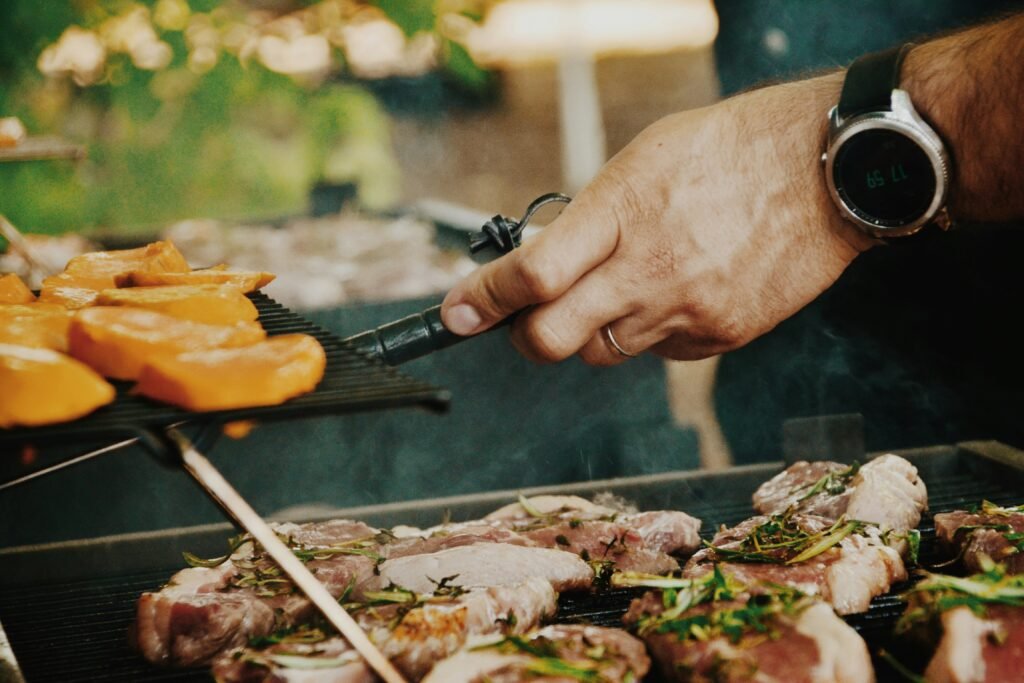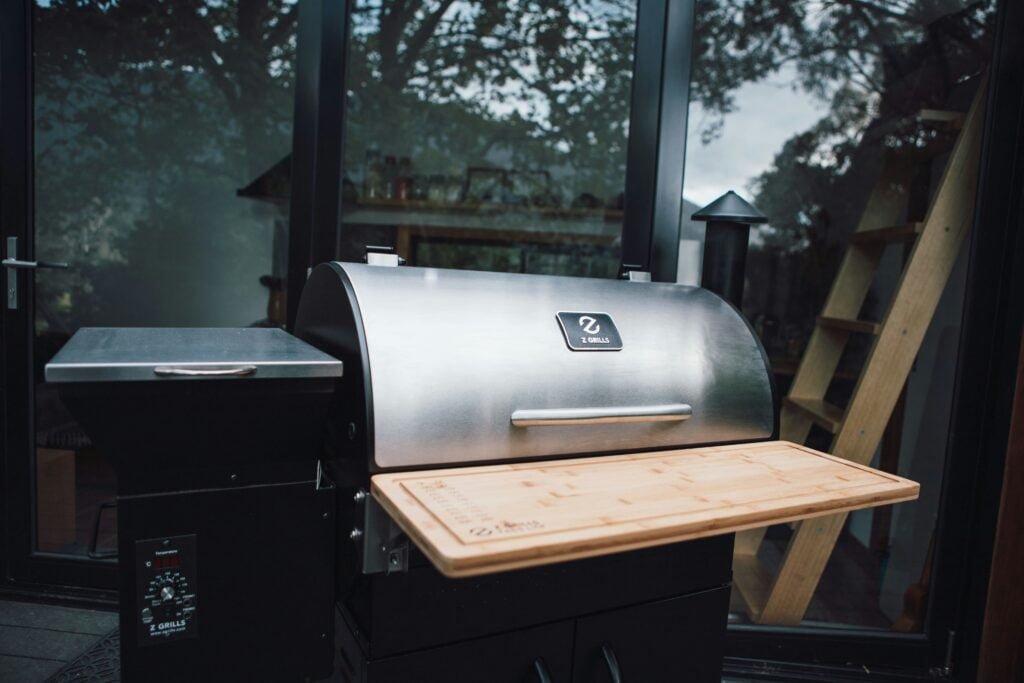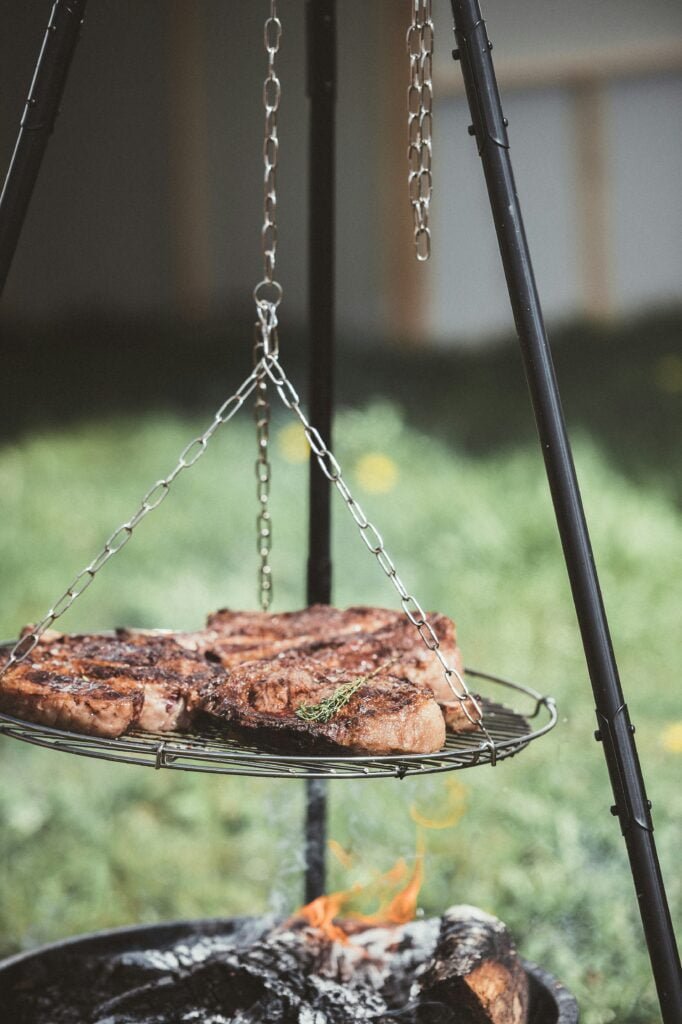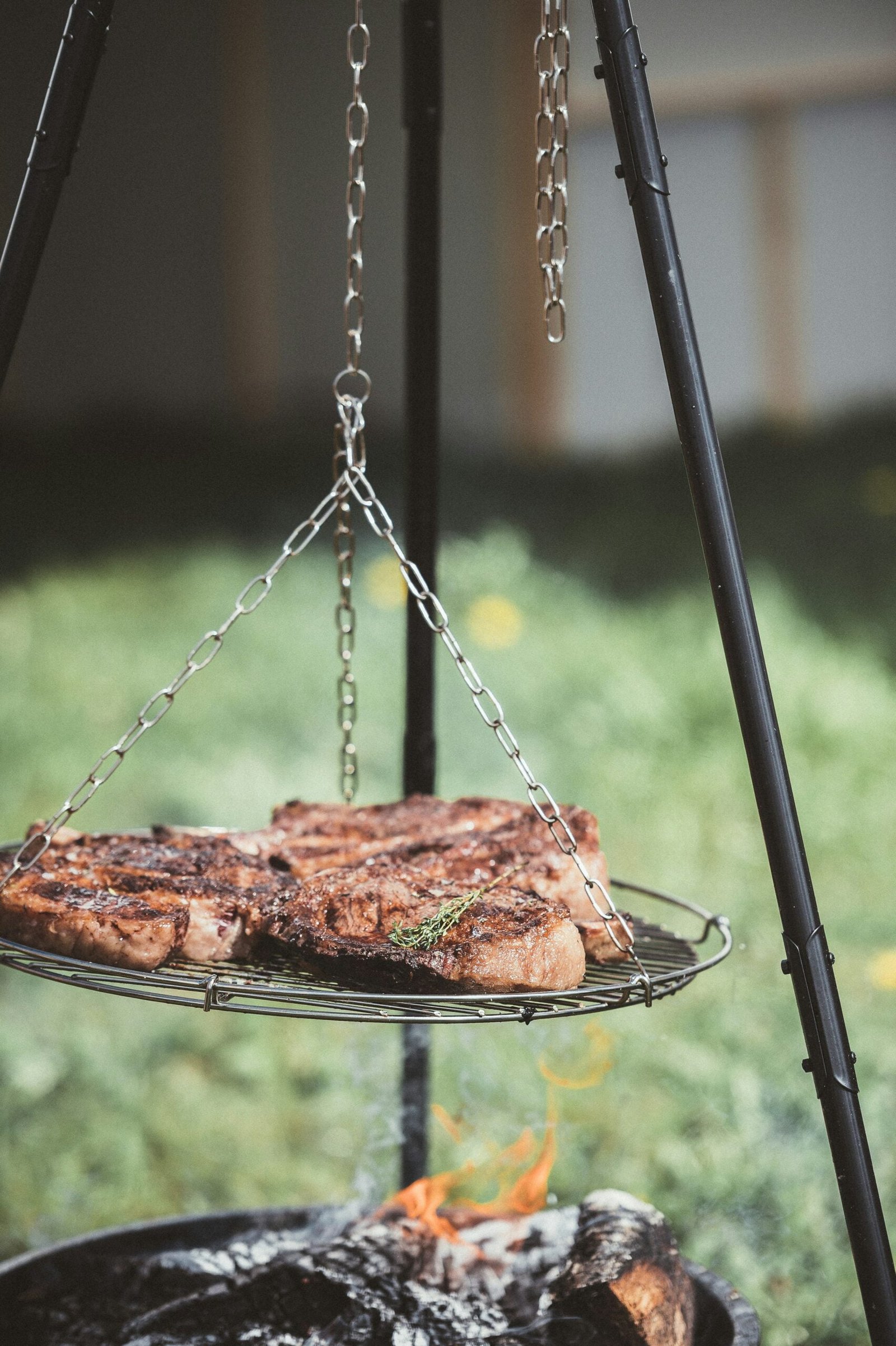Hey, have you ever wondered how those barbeque grills work their magic and leave us drooling over perfectly grilled burgers and sizzling steaks? Well, let’s peel back the curtain and take a closer look. Barbeque grills, whether charcoal, gas, or electric, all have one thing in common – they apply heat directly to the food. But it’s not just any heat; it’s the art of controlled heat that turns raw meat into a tantalizing symphony of flavors. From the sizzle of the grill grates to the heavenly aromas that waft through the air, join us on a journey to uncover how exactly these culinary companions work their smoky wonders.

Types of Barbeque Grills
Charcoal Grills
Charcoal grills are a classic choice for barbeque enthusiasts. These grills use charcoal briquettes as the main fuel source, which provide a smoky flavor to the food. One of the advantages of charcoal grills is that they can reach high temperatures, allowing for a perfect sear on steaks and burgers. They are also versatile and can be used for both direct and indirect grilling methods. However, charcoal grills require some patience and skill to get the coals lit and maintain a consistent temperature throughout the cooking process.
Gas Grills
Gas grills, on the other hand, are known for their convenience and ease of use. These grills are powered by propane or natural gas, which is ignited by a spark from the built-in ignition system. Gas grills offer precise temperature control, allowing you to adjust the heat quickly and accurately. This feature makes them ideal for cooking delicate items like fish or vegetables. Gas grills are also known for their fast heating time and low maintenance requirements, making them a popular choice for busy grillers.
Electric Grills
If you live in an apartment or have limited outdoor space, electric grills might be the perfect solution for you. These grills are powered by electricity and heat up quickly, providing a convenient option for those who cannot use charcoal or gas grills. Electric grills are compact and easy to clean, making them suitable for small gatherings or quick weeknight barbeques. However, it is important to note that electric grills may not provide the same smoky flavor as charcoal or gas grills, but they are a practical choice for those with specific limitations.
Portable Grills
Whether you are heading to a picnic, camping trip, or tailgating event, portable grills offer the flexibility to grill on the go. These grills come in various sizes and designs, catering to different needs and preferences. Portable grills can be fueled by charcoal, gas, or electricity, depending on the model. They are lightweight, compact, and usually easy to assemble and disassemble, making them highly convenient for outdoor adventures. Portable grills allow you to enjoy the pleasure of grilling wherever you may be, bringing the sizzle and delicious flavors to your outdoor escapades.
The Basics of Grilling
Understanding the Grilling Process
Grilling is a cooking method that involves using direct heat to cook food over an open flame or hot coals. Whether you are using a charcoal, gas, or electric grill, the basic principles remain the same. The heat source provides the necessary warmth to cook the food while creating those wonderful grill marks and imparting a smoky flavor. Understanding the grilling process is crucial for achieving the desired doneness and flavor in your grilled dishes.
Hazards of Grilling
While grilling is a delightful way to cook food, it is important to be aware of potential hazards. One of the main hazards of grilling is the risk of fire. It is essential to have a clear and safe grilling area, keeping the grill away from flammable materials and ensuring proper ventilation. Another hazard is burns, which can occur if you are not careful when handling hot grills or tools. Additionally, the inhalation of smoke and fumes from burning charcoal or gas can be harmful, so it’s essential to grill in a well-ventilated area.
Proper Grill Maintenance
To ensure optimal performance and prolong the lifespan of your grill, proper maintenance is essential. Regular cleaning of the grill grates and removing any grease or residue will prevent flare-ups and enhance the flavor of your food. It is also important to inspect and clean the burners, control valves, and other essential parts of the grill to ensure proper functionality. Proper storage and covering of the grill when not in use can protect it from the elements and extend its lifespan.
Fueling the Grill
Fuelling Charcoal Grills
When it comes to fueling a charcoal grill, the first step is to choose the right charcoal. There are different types available, such as briquettes or lump charcoal, each with its own advantages. Once you have selected your charcoal, it’s time to light it up. You can use either a chimney starter or lighter fluid to ignite the charcoal. It is important to allow the coals to reach the appropriate temperature before placing the food on the grill. You can control the temperature by adjusting the airflow using the grill’s vents.
Fueling Gas Grills
Gas grills require a propane tank or natural gas line to fuel the flames. Before starting, always ensure that the gas connections are secure and there are no leaks. Once the grill is safely connected, you can turn on the gas and ignite the grill using the built-in ignition system. Gas grills offer the convenience of quick heating, and with multiple burners, you have the flexibility to create different heat zones for various cooking techniques. Remember to always keep a spare propane tank on hand, especially for longer grilling sessions.
Powering Electric Grills
Electric grills are the easiest to fuel since they only require an electrical outlet. Simply plug the grill into a power source, and you’re ready to start grilling. While electric grills are convenient, they may not reach the high temperatures that charcoal or gas grills can achieve. It’s important to preheat the grill to ensure even cooking and the desired sear on your meats and vegetables. Additionally, make sure to keep the grill away from any water sources or wet surfaces to avoid electrical hazards.
Temperature Control of the Grill
Understanding Grill Temperature
Achieving the perfect grill temperature is crucial for cooking different types of food. Most grills have temperature gauges or built-in thermometers to help you monitor the heat. Understanding the different temperature ranges is essential for determining the cooking time and doneness of your food. Low heat is ideal for slow cooking or smoking, while medium heat is suitable for grilling vegetables or smaller cuts of meat. High heat is necessary for searing steaks or quickly cooking items like burgers or hot dogs.
Controlling Temperature in Charcoal Grills
In charcoal grills, controlling the temperature may take some practice, but it is certainly achievable with a few tips and tricks. The amount of charcoal, the placement of the coals, and airflow all play a role in regulating the temperature. To lower the temperature, you can reduce the airflow by closing the vents partially. For higher temperatures, increase the airflow by opening the vents wider. Additionally, you can adjust the height of the grill grates to control the heat intensity. It’s important to remember that charcoal grills take time to heat up and cool down, so patience is key.
Controlling Temperature in Gas Grills
Gas grills offer easier temperature control due to their precise heat settings. Most gas grills have multiple burners that can be individually controlled, allowing you to create different heat zones. You can turn the burners to high for searing or lower them for indirect cooking. Closing the lid will help retain the heat and create a more uniform cooking environment. If your grill doesn’t have multiple burners, you can create indirect heat by turning off one side of the burners while cooking on the other side. Experimenting with different settings will help you master the temperature control on your gas grill.

Parts of a Barbeque Grill
Grill Lid
The grill lid serves as a crucial component, helping to retain heat and distribute it evenly. It also provides protection from flare-ups and helps imbue the food with a smoky flavor. By closing the lid during cooking, you create an oven-like environment that promotes even heat distribution. Additionally, the lid acts as a shield, preventing excessive moisture loss from the food and preserving its juiciness. It’s important to keep the lid closed as much as possible while cooking, only opening it when necessary to flip or check on the food.
Cooking Grids
The cooking grids, or grates, are the surfaces on which you place your food for grilling. They can be made of various materials, such as stainless steel, cast iron, or porcelain-coated steel. Each material has its own advantages, such as heat retention or nonstick properties. It’s important to preheat the cooking grids before placing the food on them to prevent sticking. Regular cleaning of the grids is necessary to remove any food residue and maintain their performance.
Burners
Burners are an integral part of gas grills, responsible for generating the heat necessary for cooking. They can be made of stainless steel, cast iron, or brass. The number of burners in a grill depends on its size and design. Burners can be controlled individually, allowing for different heat zones and cooking techniques simultaneously. It’s essential to periodically inspect and clean the burners to ensure proper gas flow and prevent any blockages that may affect their performance.
Heat Plates
Heat plates, also known as flavorizer bars or heat tents, are found in gas grills. These metal plates are positioned between the burners and the cooking grids. Their main function is to protect the burners from drippings and flare-ups. Heat plates also help disperse heat evenly throughout the grill, reducing hot spots and creating a more consistent cooking environment. Regular cleaning of the heat plates is necessary to remove grease and food particles, ensuring optimal performance and preventing flare-ups.
Control Valves
Control valves are the knobs or dials located on the front of gas grills that allow you to adjust the heat output of each burner. These valves regulate the flow of gas to the burners, controlling the intensity of the flame. By turning the knobs, you can increase or decrease the temperature to achieve the desired level of heat. It’s important to clean and lubricate the control valves regularly to ensure smooth operation and prevent any damage or malfunction.
Cooking on the Grill
Cooking Methods
Grilling offers a variety of cooking methods, allowing you to experiment with different flavors and textures. Direct grilling is the most common method, where the food is cooked directly over the heat source. This method is perfect for items that require quick cooking times, such as burgers or steaks. Indirect grilling involves placing the food away from the direct heat, allowing for slower and more even cooking. This method is ideal for larger cuts of meat or delicate items that need a longer cooking time. Other methods include searing, smoking, and rotisserie cooking, each providing unique results and taste experiences.
Grilling vs Smoking
While grilling and smoking are both barbeque techniques, they differ in terms of cooking time, temperature, and flavor. Grilling involves cooking food relatively quickly over direct heat, resulting in a charred exterior and a moist interior. Smoking, on the other hand, is a slow and low-temperature cooking method that uses indirect heat and wood chips to infuse a smoky flavor into the food. Smoking requires more time, often several hours, to achieve the desired tenderness and rich smokiness. Both methods have their own merits and are often used in combination to create mouthwatering barbeque dishes.
Using Grill Accessories
Grill accessories can enhance your grilling experience and open up a whole new world of possibilities. Tools like long-handled tongs, spatulas, and basting brushes are essential for handling and flipping food on the grill. Grill baskets and skewers are useful for cooking smaller or delicate items that may fall through the grates. Thermometers help you monitor the internal temperature of meats, ensuring they are cooked to the desired level of doneness. Smoker boxes or wood chips add a smoky aroma to your food when using gas grills. By utilizing these accessories, you can elevate your grilling game and create more diverse and delicious dishes.

Safety Measures When Using Grills
Properly Lighting a Grill
Lighting the grill safely is of utmost importance to prevent accidents and injuries. When using a charcoal grill, avoid using lighter fluid after the coals are already lit, as this can cause flare-ups. Instead, use a chimney starter or electric starter to ignite the charcoal. When using gas grills, always open the lid before turning on the gas to prevent a buildup of propane. Make sure to read the manufacturer’s instructions and follow proper lighting procedures for your specific grill model.
Handling Flare-ups
Flare-ups, sudden bursts of flames, can occur when fat or marinade drips onto the hot coals or burners. While some flare-ups are normal, excessive ones can be dangerous. To handle flare-ups, make sure to keep a spray bottle filled with water nearby to douse the flames. You can also move the food to a cooler part of the grill to reduce the chances of flare-ups. Avoid using excessive amounts of oil or marinade that can contribute to flare-ups and always keep a close eye on the grill while cooking.
Setting Up a Safe Grill Area
Creating a safe grill area is essential to prevent accidents and ensure the well-being of everyone involved. Place the grill on a stable and non-flammable surface, such as concrete or gravel, away from any overhanging structures or trees. Ensure there is ample space around the grill to prevent any accidental bumps or burns. If grilling indoors, make sure the area is well-ventilated and keep flammable materials away. Always have a fire extinguisher or a bucket of sand nearby to handle any emergency situations.
Cleaning and Storing Grills
Cleaning Tips
Proper grill cleaning is necessary to remove grease, food residue, and other debris, ensuring a sanitary cooking surface and prolonging the life of your grill. It’s advisable to clean the grates after each use by scrubbing them with a grill brush or abrasive sponge. For charcoal grills, remove the ashes and briquettes regularly. Gas grills require additional cleaning of the burners, heat plates, and control valves to prevent clogs and maintain efficient performance. Use mild dish soap or a grill cleaner to remove stubborn stains, and always follow the manufacturer’s instructions for cleaning your specific grill model.
Proper Storage of Grills
When the grilling season comes to an end or if you won’t be using your grill for an extended period, proper storage is crucial. Before storing, ensure that the grill is completely cool and clean. Remove any removable parts, such as grates or heat plates, and clean them thoroughly. Store them separately in a dry area to prevent rust. Covering the grill with a high-quality grill cover will protect it from dust, moisture, and UV damage. If space allows, store the grill in a shed or garage to provide additional protection from the elements.
Winterizing Your Grill
For those who live in colder climates, winterizing your grill is essential to protect it from harsh weather conditions. Before winter arrives, thoroughly clean the grill and remove any excess grease or food residue. Disconnect the propane tank and store it in a well-ventilated and dry area. If you have a gas grill, it’s advisable to cover the gas line opening with a small plastic bag to prevent any critters from nesting inside. Apply a layer of high-quality grill oil or spray to the surfaces to prevent rust. Finally, cover the grill with a weather-resistant cover to keep it safe from snow, ice, and other elements.
Troubleshooting Grill Problems
Troubleshooting Charcoal Grills
Charcoal grills may occasionally encounter issues that can affect their performance. One common problem is difficulty in lighting the charcoal. If this occurs, ensure proper airflow by cleaning the vents and removing any ashes or debris. Inadequate heat or inconsistent temperatures can be a result of insufficient charcoal or improper vent adjustment. Adding more charcoal or adjusting the vents accordingly can help resolve this issue. Excessive smoke can be caused by using lighter fluid or the presence of grease in the grill. Consider using a chimney starter and keeping the grill clean to minimize smoke.
Troubleshooting Gas Grills
Gas grills can also face some common problems that can be easily resolved. If the grill does not ignite, check if the propane tank is properly connected and the gas valve is open. It is also important to ensure there is an adequate fuel supply in the tank. Uneven heat distribution may be due to clogged burners or heat plates. Cleaning these components and removing any obstructions can help restore the grill’s performance. If you notice any gas leaks, immediately turn off the gas supply and have a professional inspect and repair the grill.
Troubleshooting Electric Grills
While electric grills are generally more straightforward and have fewer issues, they may sometimes face electrical or heating problems. If the grill does not turn on, check if it is properly plugged in and tested on a functional electrical outlet. Make sure to use a grounded outlet for maximum safety. Insufficient heating may be due to wiring issues or a faulty heating element. In such cases, it is advisable to consult the manufacturer’s guide or contact customer support for further assistance. Always prioritize safety and do not attempt any repairs unless you have the necessary knowledge and expertise.
Grilling Tips and Tricks
Achieving the Best Grill Marks
Grill marks not only add visual appeal to your grilled dishes but also provide additional texture and flavor. To achieve those perfect grill marks, ensure that the grill grates are preheated thoroughly. Pat dry your meat or vegetables to prevent excess moisture, enabling proper searing. Place the food on the grill at a diagonal angle to the grates and let it cook for a few minutes without disturbing. Gently rotate the food 90 degrees to create crosshatch grill marks. Once the marks are achieved, flip the food and repeat on the other side.
Dealing with Windy Conditions
Grilling on a windy day can present some challenges, such as uneven heat distribution and difficulty in maintaining consistent temperatures. To combat these issues, position the grill in a sheltered area, like a corner or against a wall, to minimize exposure to strong gusts of wind. If possible, use a grill with a lid to help retain heat and protect the food from the wind. Additionally, closing the vents partially can reduce air circulation and help stabilize the heat inside the grill.
Grilling for Large Crowds
Grilling for a large crowd can be a daunting task, but with proper planning and organization, it can be a breeze. Start by preparing a menu and estimating the quantities of food needed for each guest. Precook some items, like chicken wings or ribs, and finish them on the grill closer to serving time. Utilize indirect cooking methods for larger cuts of meat, allowing you to cook them evenly and accommodate more food on the grill. Consider setting up a buffet-style serving area with different grilling stations, ensuring everyone gets their food hot and fresh.
Keeping Food from Sticking on the Grill
Food sticking to the grill grates can be frustrating and can result in unappetizing appearance or even loss of precious ingredients. To prevent sticking, make sure the grates are clean and well oiled before placing the food. Using a brush or towel, lightly coat the grates with vegetable oil or a non-stick cooking spray. Preheating the grates will also create a non-stick surface. Avoid flipping the food too early or too frequently, as it may cause it to stick. Patience is key; once the food has cooked for a sufficient amount of time, it will naturally release from the grates.

